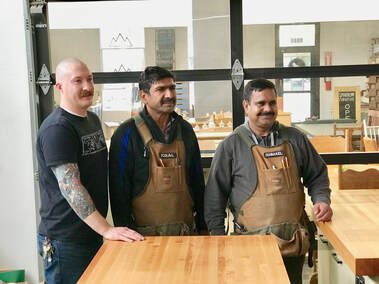 Salem for Refugees is an organization dedicated to unifying people and resources to empower refugees to thrive. The organization offers a variety of services including secure permanent housing, school enrollment, ELL, cultural orientation, healthcare, and transportation navigation to help them settle in Salem, Oregon. Their vision is “to see all refugees in Salem as valued, thriving, contributing members of our community.” A key component in this equation is finding life-sustaining employment for these refugees, or “new neighbors” as the organization prefers calling them. The role of Salem for Refugees is to help secure jobs and assist these new neighbors with transitioning into them. In the past, the organization has had success working with businesses in hospitality and want to continue strengthening their relationships in the industry. They are actively seeking out businesses to partner with throughout the Salem area. A partnership with Salem for Refugees means being open to interviewing or hiring from their communities. Partnerships also require that the business is willing to work with the unique challenges that refugees face in a foreign workforce system. For example, many of their community members speak minimal English or Spanish. Salem for Refugees provides services and solutions to these barriers that meet the needs of both their community members and industry partners. Depending on the amount of people a business is willing to employ, and the types of jobs offered, they might provide solutions like subsidized English classes or temporary translation services. They work hard to reach agreements that mutually benefit both their new neighbors and locally based businesses. Working with Salem for Refugees is a great opportunity for hospitality organizations to tap into a skilled labor force. Many of their members have gained direct and transferable skills in their home country doing hospitality or hospitality-adjacent work. A wide range of people in their talent pool have worked in hotels and restaurants, some also serving as managers in these roles. Want to learn more about Salem for Refugees and how your business can get involved? Contact Ella Sturdevant, Oregon Hospitality Foundation’s Workforce Development Coordinator, or Mohsin Jamal with Salem for refugees. Want to learn more about how to get involved with our workforce development initiatives? Maybe volunteer for guest speaking opportunities, job shadows, participate in job/career fairs or offer experiential field trips? Contact Ella Sturdevant.
0 Comments
|
AuthorsThe Oregon Hospitality Foundation (OHF) team includes Courtney Smith, ProStart Manager, Ella Sturdevant, Workforce Development Coordinator, Rebecca Donley, Hospitality Sector Strategist, and Jason Brandt, President & CEO (ORLA) / Foundation Board Member. Archives
July 2024
Categories
All
|
Membership |
Resources |
Affiliate Partners |
Copyright 2024 Oregon Restaurant & Lodging Association. All Rights Reserved.
8565 SW Salish Lane Suite 120 | Wilsonville, OR 97070-9633 | 503.682.4422 | 800.462.0619 | Contact Us
Site Map | Accessibility | Privacy Policy
8565 SW Salish Lane Suite 120 | Wilsonville, OR 97070-9633 | 503.682.4422 | 800.462.0619 | Contact Us
Site Map | Accessibility | Privacy Policy

 RSS Feed
RSS Feed


